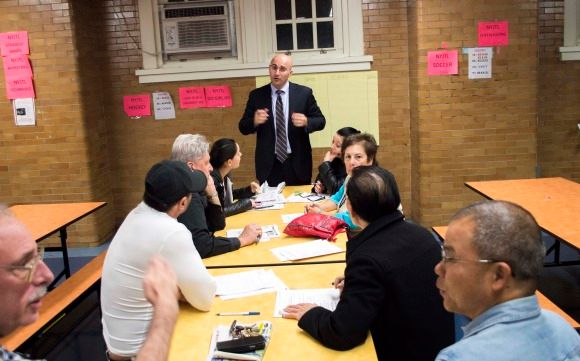Community Members Speak Up At District 47’s Participatory Budgeting Assemblies

By Aliza Chasan
When the small group of community members was asked if they were happy with the way the government spends their money, the room was silent. Hands shot up moments later when residents were asked what changes they wanted to see in their communities.
On November 10, Councilman Mark Treyger wrapped up the last of three community assemblies as part of District 47’s progressive participatory budgeting [PB] initiative. Treyger has allocated $1 million of discretionary funds for residents’ ideas. District 47 – which includes Gravesend, Bensonhurst, Sea Gate and Coney Island – is among 24 of the city’s 51 districts to sign up for PB.
At the meetings, residents filled yellow posters with Sharpie-scrawled ideas. They want street repairs, traffic cameras, bus and crosswalk countdown clocks, covered trash baskets, Wi-Fi and charging stations for parks, and bus shelters. Schools need technology upgrades, air conditioning, speed bumps, and stop signs.
“This exercise is really about empowering residents, so that residents have a direct say on how their tax dollars are at work,” says Treyger, who cites his experience as a high school teacher as his motivation for joining PB. “Equally as important, is that it’s been a great learning tool for the public to learn about the city budget process.”
The next step is for a selected group of volunteers to act as budget delegates, developing pitches into fleshed out plans and deciding which are financially feasible. Each plan will cost at least $35,000 and no more than $1 million – more expensive than replacing a stop sign, but less than building a new park from scratch. Finally, in April, constituents will vote on their favorite project.
“I want to make life easier for people in the neighborhood,” said Robert Whittaker, 40, a volunteer budget delegate. “This is the best way to do that – come here and get involved in the process.”
Another assembly goer, Maria di Graziano, 47, told us her neighborhood has been working toward PB for some time. Treyger, she said, is eager to help, which is a change from the past.
“Now it’s the community that has to get used to being present and involved and voicing their concerns,” she said.
Treyger says the goal of PB is to involve underrepresented voices in the democratic process, such as immigrants, the elderly, residents in public housing, and high school students.
Those efforts include translating flyers for the assemblies into many languages, reaching out to community organizations, and having community organizers like PBNYC and Community Voices Heard spread the word by canvassing door-to-door. Residents as young as 14 are invited to pitch ideas. To vote, community members must be 16 and have some relationship to the neighborhood, whether through work, school, or residency.
“There’s no monopoly on good ideas,” says Treyger.
To find out how you can get involved in PB, see the PBNYC website.
[With additional reporting by Rachel Silberstein]



